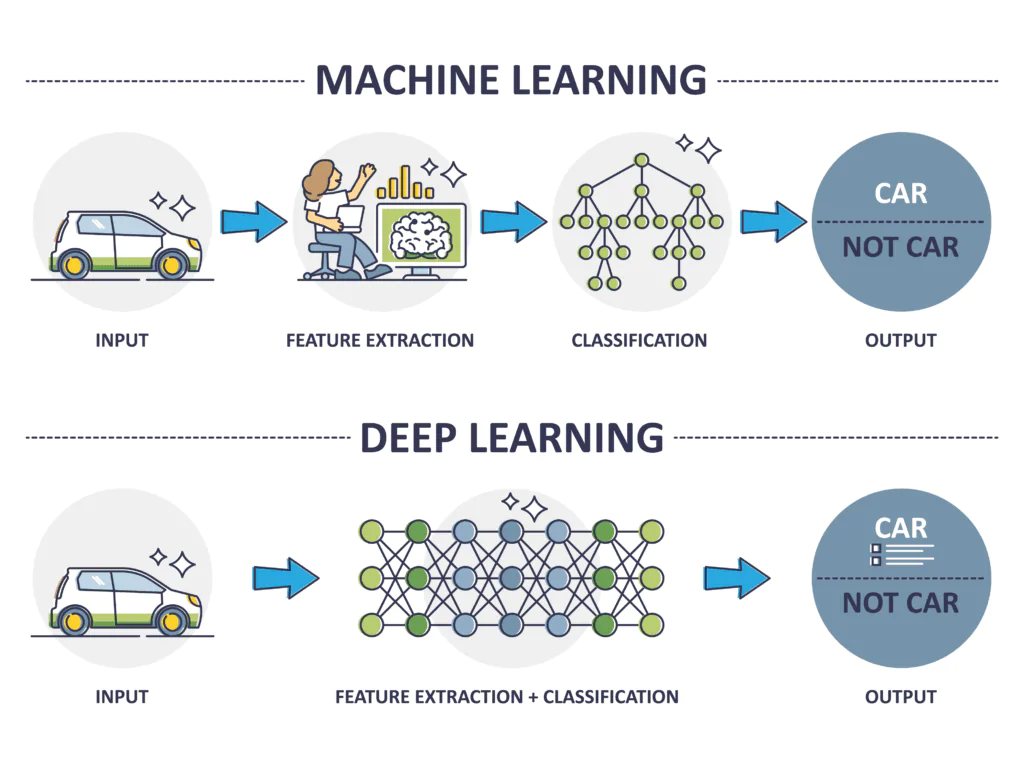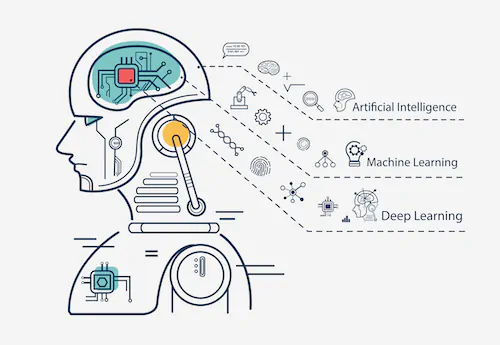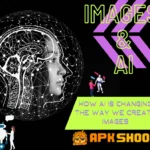Introduction:
For many years now, artificial intelligence has been changing the world, and deep learning is one of its most effective techniques. There are numerous applications of AI in human everyday life. This branch of artificial intelligence enables computers to identify patterns, forecast the future, and even gain knowledge from data. But the world of deep artificial intelligence learning can be terrifying for many newcomers. Deep AI Learning is driving a revolution in technology that is changing the way we live, work, and communicate, from self-driving cars to virtual assistants.
Whether you’re a complete beginner or have some experience with machine learning, this APKShoots guide will help you get up to speed with the fundamentals of Deep Learning.
So, let’s dive in and discover the power of Artificial Intelligence!
Deep learning is a field of machine learning that involves building and training neural networks to learn from data. It has become increasingly popular in recent years as it has shown great applications in a wide range of fields, including computer technology, natural language processing, and speech recognition. Artificial neural networks are employed in learning to process and evaluate huge amounts of data. It is a form of machine learning. Artificial neural networks can learn and develop over time since they are created to copy how the human brain functions. Deep ai learning has several uses in a variety of industries, including autonomous vehicles, healthcare, natural language processing, speech recognition, and picture and video recognition.

Learning the fundamentals of machine learning, Python programming, and neural networks is crucial if you’re interested in getting started with deep ai learning. After that, you may begin creating your first model using a framework like TensorFlow, PyTorch, or Keras.
To be successful in deep ai learning, it’s important to practice regularly, start small, learn from others, and stay up to date with the latest advancements in the field.
What is Deep Learning?
A subset of artificial intelligence enables computers to learn from data and form hypotheses or judgments based on that data. It is called “deep” learning because
The reason it uses numerous artificial neural network layers is to analyze and interpret complex data. It is fundamentally a branch of machine learning that focuses on teaching artificial neural networks to carry out tasks that generally demand human-level intellect. In other words, it’s a technique for teaching computers to learn from data and base judgments on that learning.
In short, deep ai learning is basically a branch of machine learning that require creating and training neural networks to get knowledge from data. These neural networks have interconnected nodes and are changed according to the human brain.
Importance of Deep Learning
This AI learning is significant because it has the ability to completely change how we engage with technology. Deep ai learning can be used to produce predictions that are more accurate. It also increases automation and even leads to new scientific and medical discoveries by enabling computers to recognize patterns and make decisions based on data.
How Does Deep Learning Work?
Artificial neural networks are used to evaluate data. These neural networks are capable of identifying patterns and drawing conclusions from the available information. This information includes layers of interconnected nodes and is designed like a human brain. Deep ai learning algorithms may learn to recognize complicated patterns and make predictions or judgments based on that data by training these networks with a lot of data.
the foundation of learning in Artificial neural networks is based on the structure of the human brain. These networks are made up of layers of interconnected nodes, or neurons, that process and evaluate data in order to help the network identify patterns and anticipate future outcomes.
in order to train it you must give a neural network a lot of labeled data, along with the desired output for each input. The weights and biases of the network’s neurons are modified using this data which allows the network to gradually improve its ability to make accurate predictions.
AI learning works by using a large amount of data to train a neural network. The neural network then uses this training data to make predictions or decisions about new data. The more data the network has to train on, the more accurate its predictions will be.
Types of Neural Networks
Feedforward networks, convolutional networks, and recurrent networks are a few of the neural network types that are employed in AI learning. Each category worked for particular tasks and types of data.

Training Data
To be successful, training data must be of high quality and quantity. Your neural network will perform best if you have high-quality data.
Getting Started with Deep AI Learning
If you’re interested in getting started with AI learning, here are the few steps you’ll need to follow
Step 1: Learn the fundamentals of Machine Learning
It’s crucial to have a deep understanding of machine learning before diving into learning. The practice of teaching computers to learn from and improve upon data without explicit programming is known as machine learning. The fundamentals of machine learning can be learned through online courses, publications, and tutorials. As AI Learning is a subset of machine learning, it’s crucial to understand the fundamentals of machine learning before tackling AI learning.
However, neural networks are the base of deep learning. They are designed to imitate the way the human brain works. Neural networks allow them to learn and improve over time. You can learn the fundamentals of neural networks through online courses, books, and tutorials.
Step 2: Choose Your Learning Framework
TensorFlow, PyTorch, and Keras are three famous deep-learning frameworks to pick from. It’s crucial to select the framework that best suits your needs and level of experience because each of them has benefits and limitations of its own.
Step 3: Learn Python
The most used programming language for deep ai learning is Python. It has a sizable community and numerous libraries that make working with data simple. Python can be learned using books or online courses.
Step 4: Gather Your Data
Before you can start building your ai learning model, you’ll need to gather the data that you’ll use to train it. This could include anything from images and videos to text and numerical data or any other thing you want.
Step 5: Preprocess Your Data
Once you’ve gathered your data, you’ll need to preprocess it to make it ready for your deep learning model. To guarantee that your model can use the data efficiently, this may involve cleaning, converting, and normalizing the data.
Step 6: Build Your Model
You can begin creating your learning model after preprocessing your data. This will involve selecting the type of neural network you’ll use, choosing the number of layers, and configuring the hyperparameters that will affect how your model learns from the data. At this point, you must also choose whether to use supervised, unsupervised, or reinforcement learning to train your model.
However, once you’ve learned the basics of machine learning, Python, and neural networks, it’s time to build your first deep-learning model. You can start with a simple model, such as a neural network recognizing handwritten digits. There are many tutorials and examples available online to help you get started.
Step 7: Train Your Model
Once your model is built, you’ll need to train it using your preprocessed data. This involves feeding the data into the model and adjusting the weights and biases of the neural network to improve its accuracy.
Step 8: Test Your Model
Finally, you’ll need to test your model to see how well it performs on new, unseen data. This will involve evaluating its accuracy and making any necessary adjustments to improve its performance.

Applications
Computer vision, natural language processing, speech recognition, and recommendation systems are just a few of the many uses for ai learning. Additionally, it is employed in sectors like transportation, banking, and healthcare.
1. Computer Vision
It analyzes and interprets visual data, such as images and videos. This has applications in fields such as self-driving cars, facial recognition, and medical imaging.
2. Natural Language Processing
Machines can interpret and respond to natural language thanks to ai learning, which is used to analyze and interpret text data. This has uses in areas like sentiment analysis, chatbots, and virtual assistants.
3. Speech Recognition
Machines can now detect and react to spoken language thanks to ai learning, which analyses and interprets speech data. This has uses in areas like voice-activated technology, virtual assistants, and speech-to-text transcription. This speech recognition makes it useful for applications such as virtual assistants and language translation.
4. Image and video recognition
Deep machine learning algorithms can identify and classify objects in images and videos.
5. Natural Language Processing (NLP)
It is used in NLP to process and understand human language.
6. Autonomous vehicles
It is used in autonomous vehicles to process sensor data and make decisions in real time.
7. Healthcare
It is used to analyze medical images and assist with diagnosis.
Tips for Success
Here are some tips for success when learning deep machine learning
1. Practice, Practice, Practice
It requires a lot of practice. The more you exercise your skills, the more familiar you will get with the ideas and techniques.
2. Start Small
When building your first learning ai model, start small. Don’t try to build a complex model right away. Start with a simple model and gradually increase its complexity.
3. Learn from Others
There are many online communities and forums where you can learn from others who are also learning ai technology. Joining these communities can help you stay motivated and learn new things.
4. Stay Up to Date
It is a rapidly evolving field, with new research and developments happening all the time. It’s essential to stay up to date with the latest advancements to stay relevant.
Conclusion
A tremendous technology with the potential to change the world is deep learning. It is advancing automation in a variety of industries by enabling computers to learn from data and make decisions based on that data. We can now make predictions and decisions with higher levels of accuracy because of the development and training of neural networks that learn from data. You should now have a solid knowledge of learning, its significance, and how to begin creating your own learning models after reading this learning beginner’s tutorial. Now go ahead and start the process of becoming an authority in learning! If you’re new to deep learning, we hope this beginner’s guide has helped you understand the basics and get started on your journey.
Related Post
- The Future of Artificial Intelligence
- Applications of Artificial Intelligence
- Chatbots Software for Small Businesses
FAQ
It is a component of machine learning that involves the utilization of neural networks to gain insights from data.
The amount of data needed varies depending on the complexity of the task and the size of the network. In general, the more data you have, the better your network will perform.
Python is the most commonly used programming language, although other languages such as R and MATLAB can also be used.
It is a subset of Artificial Intelligence, which also includes other areas such as Expert Systems and Rule-Based Systems.
The amount of time it takes to learn AI language depends on a variety of factors, including your prior experience with programming and machine learning, the amount of time you’re able to dedicate to learning, and the resources you have available. However, with dedication and persistence, it’s possible to learn the basics of AI learning in just a few weeks or months.
It is being implemented in healthcare, finance, and transportation. Some examples of real-world applications of ai learning include medical image analysis, fraud detection, and autonomous vehicles.
While a background in mathematics can certainly be helpful but it’s not necessarily required to learn the language. There are many resources available that can help you understand the mathematical concepts behind deep ai learning, and many frameworks have built-in functions that handle much of the math automatically.










